Temples in Maharashtra
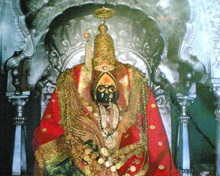 This vast land forming the western boundary of India is home to many religions and daily life is a celebration of sorts for the people.
This vast land forming the western boundary of India is home to many religions and daily life is a celebration of sorts for the people.
Maharashtra is a place dotted with pilgrim centres and places of worship as people throng the sacred venues throughout the year for one festival or the other.
A visitor to Maharashtra will find that on every single day there is a new celebration of faith by communities adding spark to otherwise dull and monotonous life.
Maharashtra with its vast boundary extending to the central, northern and Deccan plateau of India is known for temples, caves, monuments and heritage sites that shed light on its rich history, thereby shaping the national ideology.
Many centuries ago, Buddhist, Jain, Hindu and Muslim monks were believed to have taken shelter in the caves of Maharashtra for ages together.
Highly enlightened saints, philosophers and monks have guided the native people for thousands of years.
The birthplaces of religious monks and towns where they preached have been made into pilgrim centres which have been celebrated as national treasure.
Elephant caves temple, Kailash temple, Girijaatmaja Vinayak temple, Siddhivinayak temple, Varadvinayak temple, Mumbadevi temple, Mahalaxmitemple-Kolhapur, Balalji temple, Kapaleshwar temple, Muktidhamtemple,Trimbakeshwar temple and Sai Baba temple at Shirdi are the mostfamous pilgrim spots cum religious places which attract devotees throughout the year.
Deep reverence to God and joyous celebrations of various religious festivals throughout the year make Maharashtra a very colorful state.
Muktidham temple, Nashik
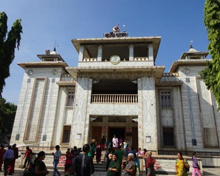 Located 7 km from Nashik town, one can see the pure white Muktidham temple near the Nashik Railway station.
Located 7 km from Nashik town, one can see the pure white Muktidham temple near the Nashik Railway station.
The temple made of white marble has a unique architecture with 18 chapters of Bhagvad Gita engraved on its wall.
A visit to this temple is considered as equivalent to visit to four 'Dhams' (4 sacred places Hindus have to visit in their lifetime).
Nashik is located on the Western Ghats on the banks of Godavari River and is famous for its scenic beauty and pleasant weather.
The holy tank of Ramkund which is believed to have been the bathing place for Lord Ram and Goddess Sita; the 2000-year-old Pandavleni Caves; the picturesque view from the Someswar temple; and the largest artillery centre of Asia are places of attractions near Muktidham temple.
Girijaatmaja Vinayak Mandir (near Pune):
Situated at Lekhan hills, 94 km from Pune, the temple is one of the eight Ashta Vinayak holy places in the state.
Girijaatmaja Vinayak Mandir is preserved on Lenyadri Parvat, expressed as "Ganapati" in the form of an infant.
Among all Ashta Vinayak places, Lenyadri is the only place that is located on the mountain, on the north-west bank of river Kukadi and in the locality of the Buddhist caves.
A pleasing shrine of Girijaatmaja is been placed on the top of the hill.
The hall of this shrine is carved on a single rock and no pillar is in the area which is 50 feet wide and 60 feet long.
It is said that the main idol is self-emerged (Swayambhu).
To get the blessing of Lord Ganapati, one has to climb 283 steps which are risky in the evening time.
Numerous people flock here to visit daily because of scenic backdrop.
'Girijaatmaj' literally means Ganesha the son of Girija (Goddess Parvati).
According to the legend, Goddess Parvati had a strong desire to have Vinayaka as her son and performed penance for 12 years in the caves of Lenyadri to fulfil her wish.
Pleased by her dedication Lord Ganesha blessed her and on the day of "Bhadrapada Shudh Chaturthi", when Parvati was worshipping an idol of Lord Ganesha it came alive and told her that her wish has been granted.
Kailash temple (Ellora caves):
Located at Ellora caves, the Kailash temple is world's largest and most complicated rock cut architecture.
This temple is dedicated to Lord Shiva and has been carved out of a single rock.
It is believed that it took over hundreds of years to scoop out 200,000 tonnes of rocks to bring the temple in shape.
The unique part of the temple is its architecture which can be divided into four sections: the temple itself, the entrance grate, Nandi shrine and the passages surrounding the courtyard.
The idol of Lord Shiva inside the temple is huge measuring 109 feet wide and 164 feet tall.
Mumbadevi temple, Mumbai:
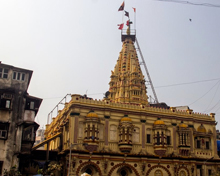 The six centuries old Mumbadevi Temple is situated at Bhuleshwar in Mumbai.
The six centuries old Mumbadevi Temple is situated at Bhuleshwar in Mumbai.
Dedicated to Goddess Mumbadevi, the city of Mumbai was named after the Mumbadevi temple.
Mumbadevi is the governing deity of Koli community who are believed to be the original inhabitants of Mumbai.
The goddess represents mother earth and is dressed in robe with silver crown, a gold necklace and a nose stud.
Mumbadevi is flanked by a tiger in front that is believed to the career of the goddess, and a shrine of Devi Annapurna seated on a peacock on the left.
Tirupathi Balaji Temple, Nerul:
As a replica of Lord Ventakeswara temple in Tirumala, the Balaji Temple of Nerul stands tall and erect offering a majestic view to devotees from a distance.
Inside the temple there is the 'Bali Peethan' and a tall 'DhwajaStambha'.
Beside these, there are a few staircases leading to the entrance hall which is also known as the Tiru Mamani Mantapam.
The hall is guarded by two divine doorkeepers - Jaya and Vijaya.
There is the Ardha Mantapam and 'garbha griham' (inner sanctum) is constructed in granite stones which are also the exact replica of the Tirupathi temple.
Devotees are only allowed to enter till the Ardha Mantapam. The idol of Balaji is placed at the sanctum.
Thousands visit the temple for bhajans, keertans, daily rituals and religious ceremonies.
Trimbakeshwar temple, Trimbak
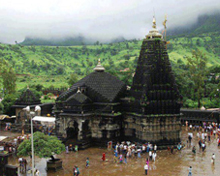 Trimbak is famous for two things - the holy temple of Trimbakeshwar and the place from where the Godavari river origins.
Trimbak is famous for two things - the holy temple of Trimbakeshwar and the place from where the Godavari river origins.
Located at a distance of 28km from Nashik, the most unique feature of the Trimbakeshwar temple is that the Shiva Linga here bears three facesof Lords Brahma, Vishnu and Shiva.
In Hindu mythology the Trimbakeshwar temple is believed to the holiest place to offer worship to Lord Shiva.
River Godavari originating from Trimbakeshwar makes it the most sacred place not only in Maharashtra but in whole India.
Kalpaleshwar temple, Nashik:
It is located on the banks of the Godavari River near Ramkund and dedicated to Lord Shiva.
The unique feature of this temple is that it does not have the statue of Nandi which is present in every other temples of Lord Shiva.
The Kalpaleshwar temple is considered to be the oldest temple of Nashik.
Siddhivinayak temple, Mumbai:
The Lord Ganesh temple at Prabhadevi, Mumbai, is the most happening place for devotees throughout the year.
Inside the temple, there is a small hall with wooden doors, gold plated roof and an idol of Ganesh with four arms.
There are also the carvings of Asthya Vinayak.
The four armed Ganesh bears a lotus, an axe, modakas, and a garland of beads.
The idol of Ganesh is also flanked by Ridhhi and Siddhi, two of his wives.
It is believed that if the Siddhivinayak temple is visited every Tuesday it brings good fortune.
The Ganesh idol has four arms and is made up of a black stone. It is 2.5 feet high and 2 feet wide.
The idol has its trunk twisted on the right which is considered to be very auspicious.
The Ganesh idol has a third eye on the forehead which denotes the third eye of Lord Shiva.
Varadvinayak temple, Raigad:
The shrine is located at Mahad village of Raigad district.
The temple is east facing and is surrounded by figures of 8 elephants on all the sides.
The northern side of the temple features the mouth of a cow and is known as Gomukh.
Holy water flows through the Gomukh's mouth. There is a holy lake on the west.
A large hall in the temple is known as 'Garbhagriha'.
There are the idols of Riddhi and Siddhi, the two wives of Ganesha.
The two idols of Lord Ganesh were placed in the hall. The idols have their trunks twisted on the left.
One of the idols is made up of white marble and the other is covered with orange vermillion.
Babulnath temple, Mumbai:
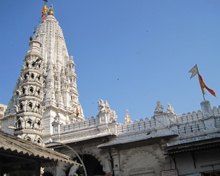 The temple of majestic Babulnath is located in the heart of Mumbai city, at nearly 1,000 feet above sea level on the Malabar Hill along the Arabian Sea.
The temple of majestic Babulnath is located in the heart of Mumbai city, at nearly 1,000 feet above sea level on the Malabar Hill along the Arabian Sea.
It is said that about two centuries ago, the southeast portion of the hilly terrain known as the Malabar Hill, belonged to one Pandurang, a rich goldsmith.
His cattle were grazing around.
Being grazing land here, there was nothing to be taken care of by Babul, the caretaker of Pandurang's cattle stock.
It was noticed that a cow named Kapila stopped giving milk.
On enquiry, Babul reported that the very cow, before coming home reaches a point and then puts out all her milk.
Babul was not able to explain the logic behind this, but had made Pandurang inquisitive.
The very next day, Pandurang witnessed the scene again and he was overwhelmed when the cow Kapila was repeating her usual act.
On reaching there, a huge Shivalinga was found. It is the very place where the temple has been built.
Chintamani Ganpati temple, Pune:
The temple located in Theur in Pune district.
It was built by Daharnidhar Maharaj Devji, a scion of Maurya Gosaviji.
Then later after hundred years Madhavrao Peshwa made the "Sabhamandap" of the temple.
A few years ago the temple's shikhar (the crest) was anointed in gold.
The idol of Chintamani is 'purvabhimukha' which is facing east and its eyes are studded with precious stones.
The main gate of the temple faces north.
There is a road that connects the Mahadwar (main gate) to the river Mula Muth.
The 'sabhamandap' of the temple is made of wood and in its centre is a fountain made of stone.
Gharishneshwar temple (Ellora caves):
This much revered temple is situated near the Buddhist caves of Ellora which is 0.5 km away.
It serves as the abode of one of the 12 Jyotirlingas in India dedicated to Lord Shiva.
Gharishneshwar temple was built between 1765 and 1795 CE.
The construction of the temple was done by a great personality called Ahilyabai Holkar of Indore.
The temple is built of red volcanic rock and sports a pink appearance on many of its architectural spots.
The famous Ajanta caves and Dulatabad town of Maharashtra are situated nearby.
The temple with exquisitely sculpted walls was also built under the patronage of Queen Ahilyabai Holkar, one of the rulers of the erstwhile state of Indore.
The most impressing feature of Gharishneshwar temple is the 5-tier shikara.
Dattatreya temple, Ganganapur:
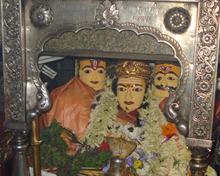 The presiding deity in Lord Dattatreya who is an incarnation of Lord Vishnu Dattatreya.
The presiding deity in Lord Dattatreya who is an incarnation of Lord Vishnu Dattatreya.
Dattatreya temple is located at a very short distance of 1km from Murud.
The temple is situated at the hill top and the idol has three heads of the Trinity Hindu gods: Brahma, Vishnu and Maheshwara.
The shrine is in the process of assuming the form of a majestic temple.
It is currently more like an ashram. The main gate of the temple faces towards the west and is built in the Maratha model of 'Nagarkhana'.
A spacious mandap (hall) is provided for the gathering.
Dagadusheth Ganapati temple, Pune:
It was founded in 1893 by Dagadusheth Halwai who is a sweetmeat seller.
He later became a wealthy businessman.
Halwai had lost his son the previous year, and at the request of his guru created the 'murtis' (image of a deity) of Ganesha and Dattatreya.
He later established the Halwai Ganapati Trust.
Bal Gangadhar Tilak, during the British Raj, gave a public form to the Ganesh festival celebrations as a way of getting around an order that barred public meetings.
It was in 1893 Balgangadhar Tilak gave a public form to the celebration of the festival of Ganpati and made it a genuinely people's festival.
Mahalakshmi temple, Mumbai:
It is one among the oldest shrines in the city located on B. Desai Road at Breach Candy in Mumbai.
It is among the most visited temples of the city.
The temple is renowned for its exclusive history and religious piety.
It is located on the seashore on the northern side of the Malabar hills.
The famous temple is particularly dedicated to Mahalakshmi, the goddess of wealth.
The main doorway of the temple is richly ornamented leading to the temple complex.
Devotees can see here various stalls that sell flower garlands and other items to make an offering to the Goddess.
Khandoba Mandir, Shirdi:
Khandoba Mandir is near Shri Sainath Hospital in Shirdi.
Khandoba is the presiding deity of the village.
The Khandoba temple is situated on the main road.
The temple has icons of Khandoba, Banai and Mhalsai.
Dedicated to Lord Shiva, the temple is known by the name Khandoba.
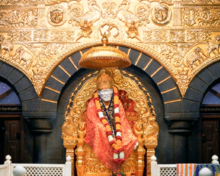 This is one of the two temples with which Sri Sai Baba had direct connections.
This is one of the two temples with which Sri Sai Baba had direct connections.
Many saints including Upasani Maharaj of Sakori stayed in this temple for their spiritual evolution.
Khandoba has the honour of welcoming Sai Baba in Shirdi.
The priest Mhalsapati called out the nameless fakir with the words 'Welcome Sai' ("Aao Sai") as He stepped on the soil of Shirdi.
Ever since, the nameless fakir came to be called as 'Sai Baba'.
The Khandoba temple can be divided into two parts, the "Mandap" and "Gabhara".
The idol of Khandoba was enshrined in the Jejuri temple which speaks volumes about the talent of its craftsmen.
The weapons situated inside the temple namely, a sword, a damaru and a paral, have historical importance attached to them.
The temple also serves as a venue of sword competition held every year on Dussehra Day.
Jejuri town is important from historical point of view.
It was here that Shivaji met his father Sahaji, after a long period of time and discussed the strategy to be followed against the Mughals.